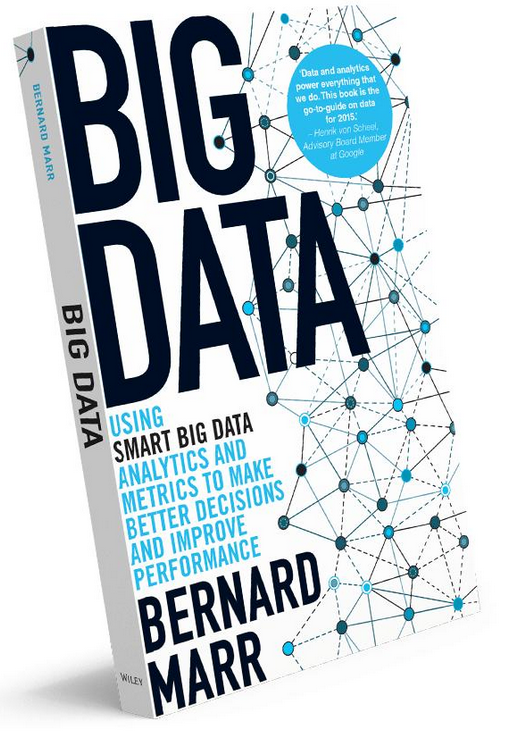How Big Data is driving smarter ways of doing business

Find out how data is creating a brave new world for businesses to thrive in: the fourth in a series leading up to the announcement of the Management Book Of The Year 2016 winners
By 2016 Management Book of the Year Shortlist author Bernard MarrBig Data is at the heart of the smart revolution. The basic idea behind the phrase ‘Big Data’ is that everything we do is increasingly leaving a digital trace (or data), which we (and others) can use and analyse to become smarter.
The driving forces in this brave new world are access to ever-increasing volumes of data and our ever-increasing technological capability to mine that data for commercial insights.
There is little doubt that Big Data is changing the world. It is already completely transforming the way we live, find love, cure cancer, conduct science, improve performance, run cities and countries and operate business.
As a result there is a huge amount of hype and fuss over Big Data. Everyone is discussing it.
It is the hot topic discussed in every boardroom, every business publication from The Economist to Fortune to the Harvard Business Review. Big Data is even making its way into mainstream media.

But despite the noise around Big Data most people still don’t really understand it and very few people know what to do about it. Personally, I don’t like the term because it’s too simplistic and potentially misleading. Granted, we are now tracking and storing data on everything so we potentially do have access to large volumes of data – hence the term Big Data. But the real value is not in the large volumes of data but what we can now do with it. It is not the amount of data that is making the difference but our ability to analyse vast and complex data sets beyond anything we could ever do before.
Innovations such as cloud computing combined with improved network speed as well as creative techniques to analyse data have resulted in a new ability to turn vast amounts of complex data into value. What’s more, the analysis can now be performed without the need to purchase or build large supercomputers. This means that any business, government body, or indeed anyone can now use Big Data to improve their decision-making.
Especially powerful is our ability to analyse so called ‘unstructured data’. Basically, unstructured data is the data we can’t easily store and index in traditional formats or databases and includes email conversations, social media posts, video content, photos, voice recordings, sounds, etc. Combining this messy and complex data with other more traditional data is where a lot of the value lies. Many companies are starting to use Big Data analytics to complement their traditional data analysis in order to get richer and improved insights and make smarter decisions.
In effect what Big Data should really stand for is SMART Data and whilst I think the term Big Data will disappear in time, the increasing production and use of SMART Data is definitely here to stay.
How companies are using Big Data
Different industries have responded to the call in different ways. Retail and sales are seeking to collect as much information about their customers’ lives as possible so as to fulfil their changing needs more effectively. Manufacturing is seeking to streamline operations. Equipment calibration settings can be recorded and refined, and product storage environments monitored to determine the optimum conditions that lead to minimum spoilage and waste.
For global companies this can mean collecting and analysing data from plants across the world, allowing minor variances to be studied and their results understood.
In 2013, for example, pharmaceutical giants Merck used analysis to dramatically cut the amount of waste caused by variance in manufacturing environment conditions. It took three months and involved 15 billion calculations on individual production data from 5.5 million vaccine batches. This allowed them to discover the optimum conditions during the fermentation process, and should greatly increase their yield, once the FDA has approved the proposed changes to the manufacturing process.
And in agriculture, data analysis is helping the industry meet the challenge of increasing the world’s food production by 60%, as forecasters have said will be necessary by 2050 due to the growing population.
Tractor and agricultural machinery manufacturer, John Deere, already fits sensors to its machinery. The data that is available to the farmers via its myjohndeere.com and Farmsight services helps them to establish optimum conditions for their crops. Plus the data is also used by John Deere to forecast demand for spare parts.
Even something as subjective and ‘human’ as Human Resources is being transformed by Big Data and analytics. Finding and keeping the right people is a major bugbear for most businesses. Talent management is fraught with challenges and the cost of failed management and leadership is enormous.
It is estimated that the average cost of executive failure is $2.7 million. Published estimates into the extent of poor leadership range from 33% to 67%. In other words between one- and two-thirds of all current leaders will fail in their role.
But it’s not just a financial cost. Unsuccessful executive appointments alone incur significant hidden costs, which can include lost opportunities, poor public relations, brand damage, poor productivity and employee disengagement and alienation.
The impact of poor leadership on employee morale can be severe: 40% of American workers classified their jobs as stressful and 75% of working adults said the most stressful part of their job was their immediate supervisor.
Getting the wrong person in any job can be a disaster. Get the wrong executive or leader and it can be catastrophic.
Evolv is a software tool which helps assess and understand employees and candidates by crunching half a billion data points across 18 industries in 13 different countries on everything from gas prices, unemployment rates and social media use, to how long a person takes to travel to work, or to how often they speak to their managers.
Although data collection methods include the controversial ‘smart badges’ that monitor employee movements and track which employees interact with each other, Evolv clients such as Bank of America are impressed.
Bank of America have reportedly improved performance metrics by 23% and decreased stress levels (measured by analysing workers’ voices) by 19%, simply by allowing more staff to take their breaks together.
The software is being used to predict a range of things including how long an employee is likely to stay in his or her job. Evolv has also gleaned some remarkable and unexpected insights such as the fact that in some careers, such as call centre work, employees with criminal records perform better than those without! Or the fact that employees who change the default browser on their computer to a nonstandard browser such as Firefox or Chrome perform better across the board than those who use a standard browser such as Internet Explorer and Safari. (Of course now this is public knowledge people could ‘game’ the predictor and change their default browser prior to interviews that will render the predictor useless.)
Although this type of Big Data analytics is currently focused on customer-facing roles it’s only a matter of time before it reaches the upper echelons of management. Certainly improving the performance of top executives has a ‘disproportionate effect on the company’ so Big Data solutions are certain to be considered.
This is an edited extract from Big Data: Using SMART Big Data, Analytics and Metrics To Make Better Decisions and Improve Performance by Bernard Marr (published by Wiley).

About the author
Bernard Marr has worked with many of the world’s best-known organisations, including the Bank of England, Accenture, Barclays, AstraZeneca, BP, Mars, Microsoft, the MoD, Orange and Shell.
He is the founder and CEO of the Advanced Performance Institute, has been named by LinkedIn as one of the world’s top 100 business influencers and has written a number of books and more than 300 high-profile reports.
Bernard Marr's Big Data: Using SMART Big Data, Analytics and Metrics To Make Better Decisions and Improve Performance is shortlisted in the Management Futures category of the 2016 CMI Management Book of the Year, in association with the British Library and sponsored by Henley Business School

Press & Media Enquiries
For more information or to request interviews, contact CMI's Press Team on 020 7421 2705 or email press.office@managers.org.uk


